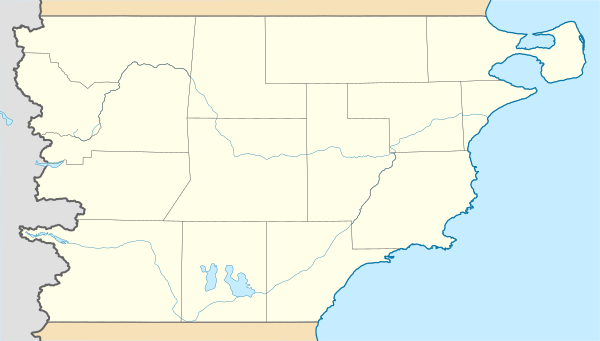Y Wladfa
Y Wladfa (Welsh pronunciation: [ə ˈwladva], "The Colony"),[2] also occasionally Y Wladychfa Gymreig (Welsh pronunciation: [ə wlaˈdəχva ɡəmˈreiɡ], "The Welsh Settlement"),[3][4] is a successful Welsh settlement in Argentina, which began in 1865 and occurred mainly along the coast of Chubut Province in Patagonia.
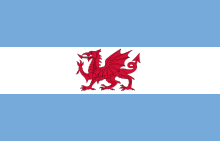 Flag of the Welsh colony in Patagonia | |
| Total population | |
|---|---|
| 50,000[1] | |
| Regions with significant populations | |
| Chubut Province | |
| Languages | |
| Spanish, Patagonian Welsh (10%)[1] | |
| Religion | |
| Protestantism (mostly Methodism and Presbyterianism) and Roman Catholicism | |
| Related ethnic groups | |
| Welsh, Argentines, English Argentines, Irish Argentines, Scottish Argentines, Welsh Brazilians, Welsh Americans, Welsh Canadians, Welsh Australians |
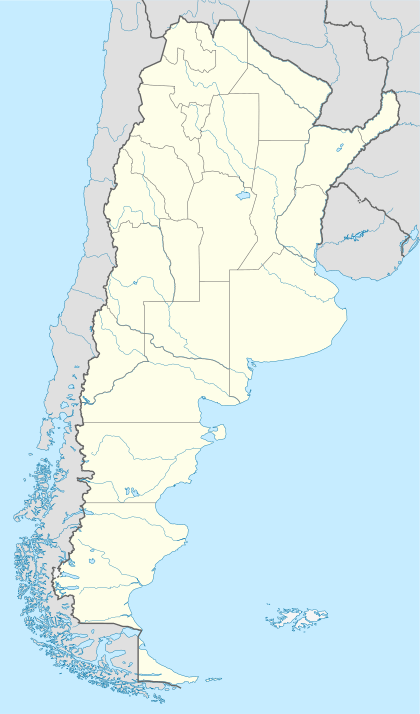
In the 19th and early 20th century the Argentine government encouraged emigration from Europe to populate the country outside the Buenos Aires region; between 1856 and 1875, 34 settlements of immigrants of various nationalities were established in Santa Fe and Entre Ríos. In addition to the main colony in Chubut, a smaller colony was set up in Santa Fe by 44 Welsh people who left Chubut, and another group settled at Coronel Suárez in southern Buenos Aires Province.[5][6]
The Welsh-Argentine community is centred on Gaiman, Trelew and Trevelin.[7] Chubut estimates the number of Patagonian Welsh speakers to be about 1,500, while other estimates put the number at 5,000.[8][9]
History
First settlers 1865
.jpg)
The idea of a Welsh colony in South America was put forward by Michael D. Jones, a Welsh nationalist nonconformist preacher[10]:23 based in Bala, Gwynedd, who had called for a new "little Wales beyond Wales". He spent some years in the United States, where he observed that Welsh immigrants assimilated very quickly compared with other peoples and often lost much of their Welsh identity.[10]:22 He proposed setting up a Welsh-speaking colony away from the influence of the English language. He recruited settlers and provided financing; Australia, New Zealand and even Palestine were considered, but Patagonia was chosen for its isolation and the Argentines' offer of 100 square miles (260 km2) of land along the Chubut River in exchange for settling the still-unconquered land of Patagonia for Argentina.[10]:23–30 Michael D Jones had been corresponding with the Argentinean government about settling an area known as Bahía Blanca where Welsh immigrants could preserve their language and culture. The Argentinean government granted the request as it put them in control of a large tract of land. A Welsh immigration committee met in Liverpool and published a handbook, Llawlyfr y Wladfa, to publicise the scheme to form a Welsh colony in Patagonia which was distributed throughout Wales.

Towards the end of 1862, Captain Love Jones-Parry and Lewis Jones (after whom Trelew was named) left for Patagonia to decide whether it was a suitable area for Welsh emigrants. They first visited Buenos Aires where they held discussions with the Interior Minister Guillermo Rawson then, having come to an agreement, headed south. They reached Patagonia in a small ship named the Candelaria, and were driven by a storm into a bay which they named Porth Madryn after Jones-Parry's estate in Wales. The town which grew near the spot where they landed is now named Puerto Madryn. On their return to Wales they declared the area to be very suitable for colonisation.

On 28 July 1865 153 Welsh settlers arrived aboard tea clipper Mimosa.[11] The Mimosa settlers, including tailors, cobblers, carpenters, brickmakers, and miners, comprised 56 married adults, 33 single or widowed men, 12 single women (usually sisters or servants of married immigrants), and 52 children; the majority (92) were from the South Wales Coalfield and English urban centres.[10]:35 There were few farmers, which was rather unfortunate particularly when they discovered that the attractions of the area had been oversold and they had landed in an arid semi-desert with little food; they had been told that the area was like lowland Wales. At the coast there was little drinking water, and the group embarked on a walk across the parched plain with a single wheelbarrow to carry their belongings. Some died and a baby, Mary Humphries, was born on the march. John Williams was the only colonist with any form of rudimentary medical skill. So disheartened were some settlers, they requested that the British Government settle them on the Falkland Islands. However this request was ignored.
Once they reached the valley of the Chubut River, their first settlement was a small fortress on the site which later became the town of Rawson, now the capital of Chubut Province.[10]:45 This was referred to as Yr Hen Amddiffynfa ('The Old Fortress').[10]:44 The first houses, constructed from earth, were washed away by a flash flood in 1865, and new houses of superior quality were built to replace them.[10]:45–47 The floods also washed away crops of potatoes and maize.[10]:52 The rainfall in the area was much less than the colonists had been led to expect, leading to crop failures.
Consolidation 1866–1888
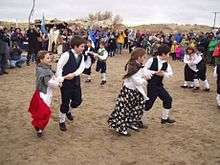

The settlers first made contact with the local Tehuelche people almost a year after their arrival. After some difficult early years of suspicion and some violence, the Tehuelche people established cordial relationships with the Welsh and helped the settlement survive the early food shortages. The settlers, led by Aaron Jenkins (whose wife Rachel was the first to bring up the idea of systematic use of irrigation canals), soon established Argentina's first irrigation system based on the Chubut River (in Welsh, Afon Camwy, 'winding river'), irrigating an area three or four miles (five or six km) to each side of the 50-mile (80 km) long stretch of river and creating Argentina's most fertile wheatlands. By 1885, wheat production had reached 6,000 tons, with wheat produced by the colony winning the gold medal at international expositions at Paris and Chicago.
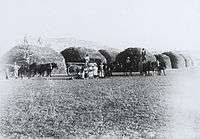
The mouth of the Chubut River was difficult to navigate, being shallow and with shifting sandbanks, and it was decided that a railway was required to connect the Lower Chubut valley to Puerto Madryn (originally Porth Madryn) on the Golfo Nuevo on the southern side of the Valdes Peninsula.[10]:80–81 Lewis Jones was the driving force, and in 1884 the Argentine Congress authorised the construction of the Central Chubut Railway by Lewis Jones y Cía. Raising funds for the project locally proved difficult, so Lewis Jones went to the United Kingdom to seek funds, where he enlisted the assistance of Asahel P. Bell, an engineer. Work on the railway began in 1886, helped by the arrival of another 465 Welsh settlers on the steamer Vesta. The town which grew at the railhead was named Trelew (Town of Llew) in honour of Lewis Jones.[10]:86 The town grew rapidly and in 1888 became the headquarters of the Compañía Mercantil del Chubut (Chubut Trading Company). Initially the settlers were largely self-governing, with all men and women of 18 years of age or over having the right to vote.
In January 1868, the first newspaper of the colony, Y Brut (The Chronicle), appeared; Ein Breiniad (Our Privilege) followed in 1878. Both were short-lived with only six issues of each title being circulated. Lewis Jones established Y Dravod (The Discussion) in 1891, and this had greater longevity, with a weekly issue being produced until 1961.[12]
Expansion towards the Andes 1885–1902
By the mid-1880s most of the good agricultural land in the Lower Chubut valley had been claimed, and the colonists mounted a number of expeditions to explore other parts of Patagonia to seek more cultivable land. In 1885, the Welsh asked the governor of Chubut Province, Luis Jorge Fontana, for permission to arrange an expedition to explore the Andean part of Chubut. Fontana decided to accompany the expedition in person. By the end of November 1885 they had reached a fertile area which the Welsh named Cwm Hyfryd (Pleasant Valley). By 1888, this site at the foot of the Andes had become another Welsh settlement,[12] named in Spanish Colonia 16 de Octubre. As the population grew here, the towns of Esquel and Trevelin were founded.
In 1893 a Welsh-language newspaper called Y Drafod was founded by Lewis Jones in order to promote Welshness in Y Wladfa.[13]
This area became the subject of the Cordillera of the Andes Boundary Case 1902 between Argentina and Chile. Initially the border was defined by a line connecting the highest peaks in the area, but it later became clear that this line was not the same as the line separating the watersheds, with some of the rivers in the area flowing westwards. Argentina and Chile agreed that the United Kingdom should act as arbitrator, and the views of the Welsh settlers were canvassed. In 1902, despite an offer of a league of land per family from Chile, they voted to remain in Argentina.
Setbacks in the Lower Chubut Valley 1899–1915
Serious damage was caused by floods in the 1890s and 1900s, which devastated Rawson and to a lesser extent Gaiman, though Trelew was not affected. There was also disagreement between the settlers and the government of Argentina, which introduced conscription and insisted on males of military age drilling on Sundays. This ran counter to the Sabbatarian principles of the settlers and caused much ill-feeling, though the matter was eventually resolved by the intervention of the president of Argentina, Julio Argentino Roca. These factors, and a lack of unclaimed farmable land, caused 234 people to leave for Liverpool aboard the Orissa on 14 May 1902, with 208 of them subsequently travelling to Canada, arriving at Saltcoats, Saskatchewan, in late June[14] although some of these families later returned to Chubut, others later migrated to Australia. Some other settlers moved to Río Negro Province in Argentina. Many of those who left Chubut were late arrivals who had failed to obtain land of their own, and they were replaced by more immigrants from Wales. By the end of the 19th century there were some 4,000 people of Welsh descent living in Chubut. The last substantial migration from Wales took place shortly before World War I, which put a halt to further immigration. Approximately 1,000 Welsh immigrants arrived in Patagonia between 1886 and 1911; on the basis of this and other statistics, Glyn Williams estimated that perhaps no more than 2,300 Welsh people ever migrated directly to Patagonia.[15]
Later development
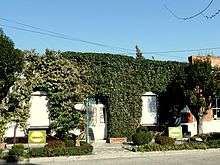
Immigration to the area after 1914 was mainly from Italy and other southern European countries: Welsh became a minority language. The creation of a cooperative, the Cwmni Masnachol Camwy (Spanish: Compañía Mercantil de Chubut), was important. The Society traded on the settlers' behalf in Buenos Aires and acted as a bank with 14 branches. The cooperative society collapsed in the Great Depression of the 1930s. The construction of a dam on the Rio Chubut 120 kilometres (75 mi) west of Trelew, inaugurated on 19 April 1963, removed the risk of flooding in the Lower Chubut Valley.
The Welsh have left their mark on the landscape, with windmills and chapels across the province, including the distinctive wood and corrugated zinc Capel Salem and Trelew's Salon San David. Many settlements along the valley bear Welsh names.

In 2006, the first of a two-Test tour to Argentina by the Wales national rugby union team was played in Puerto Madryn, which was a 27–25 win for Argentina.
As of 2016, 1,270 people undertook Welsh courses in the region, the highest number on record for the project.[16] There are three bilingual Welsh/Spanish primary schools in the province of Chubut, namely Ysgol yr Hendre in Trelew, Ysgol Gymraeg y Gaiman in Gaiman, and Ysgol Y Cwm in Trevelin.[17]
Every year the Eisteddfod festival takes place in the town of Trevelin.[18]
In 2014 Professor Wyn James of Cardiff University estimated there were about 5,000 people in Patagonia who speak Welsh.[19]
On 28 July 2015 celebrations took place to celebrate the 150th anniversary of the Welsh migrations. First Minister of Wales, Carwyn Jones attended the celebration.[20]
Welsh language names for Argentine places

| Spanish | Welsh | English |
|---|---|---|
| Argentina | Yr Ariannin | The Argentine |
| Villa La Angostura | Lle Cul | Narrow Place |
| Arroyo Pescado | Nant y Pysgod | Fish Stream |
| Colonia 16 de Octubre | Cwm Hyfryd/Bro Hydref | Beautiful Valley/Autumn Community |
| Fuerte Aventura | Caer Antur | Fort Adventure |
| Paso de Indios | Rhyd yr Indiaid | Indians' Ford |
| Las Plumas | Dôl y Plu | Meadow of the Feathers |
| Puerto Madryn | Porth Madryn | Port Madryn |
| Rawson | Trerawson | Rawson, Chubut |
| Río Chubut (from Tehuelche 'Chupat', meaning 'shining, glinting') | Afon Camwy | Swirling River |
| Río Corintos | Aber Gyrants | Turning Estuary |
| Valle de los Mártires | Dyffryn y Merthyron | Valley of the Martyrs |
| Valle Frío | Dyffryn Oer | Cold Valley |
| Trelew | Tre Lew(is) | Lewis Town |
| Dolavon | Dôl Afon | River Meadow |
| Trevelin | Tre Felin | Mill Town |
Anthem
Y Wladfa's anthem is a re-working of the Welsh anthem, "Hen Wlad Fy Nhadau", called "Gwlad Newydd y Cymry" ('"The New Country of the Welsh"'). The new anthem was penned by Lewis Evans and is sung to the same tune as "Hen Wlad Fy Nhadau".
Popular culture
Patagonia is a film about the Welsh settlement in Argentina.[21]
See also
Notes
- "Wales and Argentina". Wales.com website. Welsh Assembly Government. 2008. Archived from the original on 16 October 2012. Retrieved 24 December 2010.
- National Library of Wales' bibliography for 'The Welsh settlement in Patagonia'
- Gwladychfa Gymreig, being an essay by the Rev. Michael D. Jones probably written during the early 1860s, outlining his vision of a Welsh settlement.
- Banner Cymru, Mercher, Mawrth 4, 1857, Cyf. I, Rhif 1, p. 7, col. C, article about a meeting in Caernarfon to discuss the advantages and disadvantages of Patagonia as somewhere to establish "Y Wladychfa Gymreig"; see also Williams, R. Bryn, Gwladfa Patagonia: The Welsh Colony in Patagonia 1865–1965 (Gwasg Prifysgol Cymru, Caerdydd, 1965), plate facing p. 33, showing printed money notes for "Gwladychfa Gymreig Patagonia", with one also bearing the stamp "Y Wladychfa Gymreig"
- Birt, Paul W. (2005). "Welsh (in Argentina)". In Diarmuid Ó Néill (ed.). Rebuilding the Celtic Languages. Talybont: Y Lolfa. p. 146. ISBN 978-0-86243-723-7.
- "Wales and Patagonia". 26 June 2015. Retrieved 4 May 2017.
- Berresford Ellis, Peter (1983). The Celtic revolution: a study in anti-imperialism. Talybont: Y Lolfa. pp. 175–178. ISBN 978-0-86243-096-2.
- Western Mail, 27 Dec 2004
- "Viewpoint: The Argentines who speak Welsh". BBC News. 16 October 2014. Retrieved 16 October 2014.
- Williams, Glyn (1975). The desert and the dream: A study of Welsh colonization in Chubut 1865 – 1915. Cardiff: University of Wales Press. ISBN 978-0-7083-0579-9.
- Wilkinson, Susan (September 1998). "Welsh immigrants in Patagonia: Mimosa, the old ship that sailed into history". (originally) Buenos Aires Herald. Retrieved 5 January 2007.
- "The Welsh colony in Patagonia". Collections: Printed materials. The National Library of Wales. 2015. Retrieved 19 June 2015.
- "Y Drafod - Welsh Newspapers Online - the National Library of Wales".
- Williams, Colin H. "Multicultural Canada — Welsh". Multicultural Canada Project, Simon Fraser University. Archived from the original on 26 June 2007. Retrieved 1 July 2007.
- Glyn Williams (1969). "The Welsh in Patagonia: A Demographic Note". Norsk Tidsskrift for Sprogvidenskap. Supplementary volume: 238.
- "Patagonia: Y Gymraeg yn 'fwy diogel'". BBC Cymru Fyw. 6 June 2017. Retrieved 6 June 2017.
- "Welsh Language Project | British Council". wales.britishcouncil.org. Retrieved 6 June 2017.
- "The Eisteddfod of Trevelin - Trevelin, Patagonia, Argentina".
- "The Argentines who speak Welsh". BBC News. 16 October 2014.
- "The Welsh are fully integrated to Argentina and have preserved their culture". MercoPress. 28 July 2015. Retrieved 28 September 2019.
- Booth, Hannah (2 March 2011). "Matthew Rhys: From Patagonia with love". The Guardian.
References
- Western Mail (Cardiff, Wales). 27 Dec 2004. Patagonia Welsh to watch S4C shows.
- Glyn Williams (1975). The desert and the dream: a study of Welsh colonization in Chubut 1865–1915. University of Wales Press. ISBN 978-0-7083-0579-9.
- R. Bryn Williams (2000). Gwladfa Patagonia 1865–2000 = La colonia galesa de Patagonia 1865–2000 = The Welsh colony in Patagonia 1865–2000. Gwasg Carreg Gwalch. ISBN 978-0-86381-653-6.
- Walter Ariel Brooks, 'Welsh print culture in y Wladfa: The role of ethnic newspapers in Welsh Patagonia, 1868-1933' (Cardiff University PhD thesis, 2012) - https://orca.cf.ac.uk/46450/1/WelshPrintCultureInYWladfaWalterBrooks.pdf
- E. Wyn James, ‘Identity, Immigration, and Assimilation: The Case of the Welsh Settlement in Patagonia’, Transactions of the Honourable Society of Cymmrodorion, 24 (2018), 76-87. ISSN 0959-3632.
External links
| Wikimedia Commons has media related to Welsh diaspora in Argentina. |
- Project-Hiraeth – Documents the stories of the Welsh colony in Patagonia, Argentina through film, text and illustration.
- Glaniad – A website that tells the story of the Welsh settlements in Patagonia
- Y Wladfa — The Welsh in Patagonia on h2g2
- BBC Wales History on the Welsh migration to Patagonia
- Andes Celtig A trilingual website with information, maps and photographs of the Welsh settlements in Patagonia
- Teithiau Tango A bilingual website with in-depth history of the Welsh Patagonia region.
- A Place of Meadows and Tall Trees: a novel based on the early years of the Patagonian settlement by Clare Dudman.
- BBC News: Viewpoint – The Argentines who speak Welsh
- Patagonian Welsh national anthem discovered in 19th century pamphlet
- Videos of papers at a conference on Wales and the Welsh Settlement in Patagonia held at Aberystwyth University, 6 June 2015.
- Videos of papers at a conference on Wales and the Welsh Settlement in Patagonia held at Cardiff University, 6-7 July 2015.
